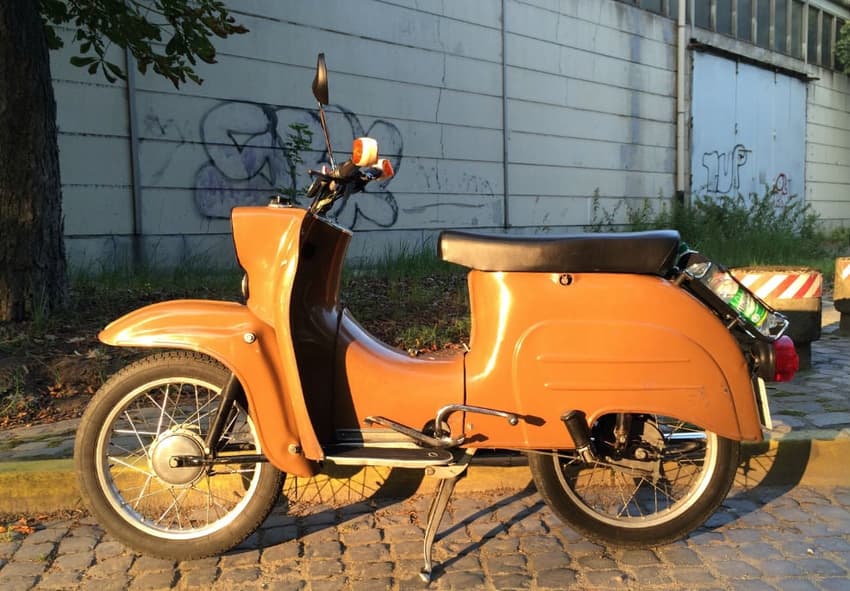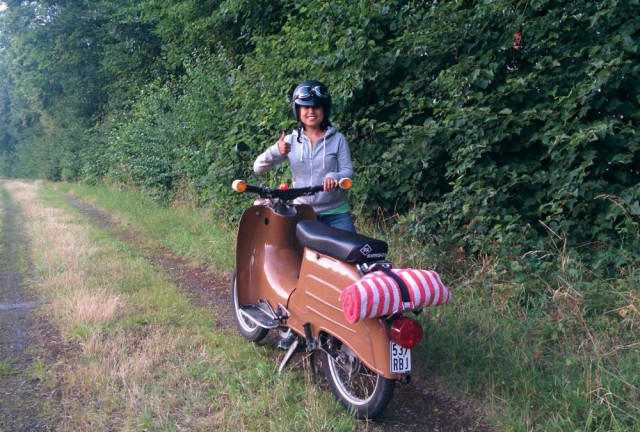Here’s a little-known East German vehicle that’s actually amazing

While the Trabant is a car made in East Germany that’s known for being noisy, slow and extremely polluting, the Simson Schwalbe - a moped from the GDR - is a wondrous vehicle that comes with lots of advantages.
I don’t own a house or a car, but I am a proud Simson Schwalbe moped owner - an original one at that. (Several modern versions have been produced of late).
Purchased four years ago in mint condition from an elderly man in a small town close to Bremen, it’s probably the best investment I’ve ever made.
Built in 1985 in the German Democratic Republic (GDR), it’s older than me. But of all the years I’ve had it now, it’s never let me down.
For about two years, aside from the wintertime, I drove it every day to work and back - about 20 kilometres. In addition to its durability though, there are many more reasons why owning a Schwalbe is so awesome.
Neues Gefährt im Fuhrpark
. . .#newride #simson #simsonschwalbe #schwalbe #retro #hipster #rheinhessen #zweitakter #zweitakt #ddrschwalbe … pic.twitter.com/GL7Fite1bp
— Lukas Zintel (@lukaszintel) July 8, 2017
Firstly, it’s fast. With an engine size of 50 cubic centimetres, the Schwalbe can go up to 60 kilometres per hour, which stands in stark contrast to newer mopeds.
With a standard driver’s license in Germany, you’re technically only entitled to drive a moped with an engine size of 50 cubic centimetres at a maximum speed of 45 kilometres per hour. Many scooters produced nowadays are designed as such and the Schwalbe is an exception.
The Schwalbe is also rather easy to fix yourself, which means it’s cheap to maintain if you’re handy.
My partner is an engineer and he’s been able to repair our Schwalbe on multiple occasions instead of us having to take it to the shop. For instance, we once saved an estimated €50 when he changed the gasket of the moped himself.
According to him, the Schwalbe is engineered in such a way that it is simple and compact, lending itself very well to being fixed by amateurs. He says that there are lots of helpful tutorial videos online for Schwalbe repairs that even people who aren’t good with their hands can follow (like me).
A further benefit for those that do choose to get their hands dirty is that parts for the Schwalbe are very accessible as there’s a pretty huge after-sales market for the model, too. By comparison, getting your hands on spare parts for a Vespa moped is much more difficult.
Not only is maintenance cheap, the cost of driving a Schwalbe is relatively low.
When I was driving it to work every day, petrol cost up to €32 per month - about half of what I would’ve had to pay if I had gotten a monthly transit pass. Not to mention insurance only costs around €40 a year.
 Hitting the open road. Photo: Shelley Pascual.
Hitting the open road. Photo: Shelley Pascual.
But none of these advantages top the best thing about owning a Simson Schwalbe, which for me is the unique experience it offers.
Before I owned one, I never knew what it was like to ride down the street on a two-wheeler and to turn people’s heads. People often give me the thumbs-up sign with big grins on their faces as I’m out for a ride on my Schwalbe.
I also had never before been stopped by random strangers in parking lots who, fascinated by my moped, started asking me questions about the Schwalbe such as its age, where it’s from and how I got my hands on it.
This kind of thing happens quite often whenever I’m out on my trusty steed; it’s shown me that not all Germans despise small talk, particularly when it's on the topic of something interesting or meaningful to them.
So sure, it’s great that the Schwalbe’s reliable, fast and cheap in terms of maintenance and petrol costs. The fact that just over one million Simson Schwalbe vehicles were produced in the GDR is pretty cool, too. This means that it'll likely get harder to get your hands on an original as each year passes.
Nowadays you can spend anywhere from €500 to €1,000 for a second hand Schwalbe (we spent €1,000 on ours) and up to €2,000 for a fully restored one.
The only potential downside I’d say about the vehicle is that it’s manual rather than automatic. This meant it took me a few days to learn how to drive it and about two weeks until I felt confident driving it.
Still, the pros definitely still outweigh the cons. Another pro is that it can carry up to two people.
What this means is that you can share the experience of joyriding on a Schwalbe at 60 kilometre per hour speeds through the countryside with someone else - one of my all-time favourite pastimes.
Comments
See Also
I don’t own a house or a car, but I am a proud Simson Schwalbe moped owner - an original one at that. (Several modern versions have been produced of late).
Purchased four years ago in mint condition from an elderly man in a small town close to Bremen, it’s probably the best investment I’ve ever made.
Built in 1985 in the German Democratic Republic (GDR), it’s older than me. But of all the years I’ve had it now, it’s never let me down.
For about two years, aside from the wintertime, I drove it every day to work and back - about 20 kilometres. In addition to its durability though, there are many more reasons why owning a Schwalbe is so awesome.
Neues Gefährt im Fuhrpark
— Lukas Zintel (@lukaszintel) July 8, 2017
. . .#newride #simson #simsonschwalbe #schwalbe #retro #hipster #rheinhessen #zweitakter #zweitakt #ddrschwalbe … pic.twitter.com/GL7Fite1bp
Firstly, it’s fast. With an engine size of 50 cubic centimetres, the Schwalbe can go up to 60 kilometres per hour, which stands in stark contrast to newer mopeds.
With a standard driver’s license in Germany, you’re technically only entitled to drive a moped with an engine size of 50 cubic centimetres at a maximum speed of 45 kilometres per hour. Many scooters produced nowadays are designed as such and the Schwalbe is an exception.
The Schwalbe is also rather easy to fix yourself, which means it’s cheap to maintain if you’re handy.
My partner is an engineer and he’s been able to repair our Schwalbe on multiple occasions instead of us having to take it to the shop. For instance, we once saved an estimated €50 when he changed the gasket of the moped himself.
According to him, the Schwalbe is engineered in such a way that it is simple and compact, lending itself very well to being fixed by amateurs. He says that there are lots of helpful tutorial videos online for Schwalbe repairs that even people who aren’t good with their hands can follow (like me).
A further benefit for those that do choose to get their hands dirty is that parts for the Schwalbe are very accessible as there’s a pretty huge after-sales market for the model, too. By comparison, getting your hands on spare parts for a Vespa moped is much more difficult.
Not only is maintenance cheap, the cost of driving a Schwalbe is relatively low.
When I was driving it to work every day, petrol cost up to €32 per month - about half of what I would’ve had to pay if I had gotten a monthly transit pass. Not to mention insurance only costs around €40 a year.
 Hitting the open road. Photo: Shelley Pascual.
Hitting the open road. Photo: Shelley Pascual.
But none of these advantages top the best thing about owning a Simson Schwalbe, which for me is the unique experience it offers.
Before I owned one, I never knew what it was like to ride down the street on a two-wheeler and to turn people’s heads. People often give me the thumbs-up sign with big grins on their faces as I’m out for a ride on my Schwalbe.
I also had never before been stopped by random strangers in parking lots who, fascinated by my moped, started asking me questions about the Schwalbe such as its age, where it’s from and how I got my hands on it.
This kind of thing happens quite often whenever I’m out on my trusty steed; it’s shown me that not all Germans despise small talk, particularly when it's on the topic of something interesting or meaningful to them.
So sure, it’s great that the Schwalbe’s reliable, fast and cheap in terms of maintenance and petrol costs. The fact that just over one million Simson Schwalbe vehicles were produced in the GDR is pretty cool, too. This means that it'll likely get harder to get your hands on an original as each year passes.
Nowadays you can spend anywhere from €500 to €1,000 for a second hand Schwalbe (we spent €1,000 on ours) and up to €2,000 for a fully restored one.
The only potential downside I’d say about the vehicle is that it’s manual rather than automatic. This meant it took me a few days to learn how to drive it and about two weeks until I felt confident driving it.
Still, the pros definitely still outweigh the cons. Another pro is that it can carry up to two people.
What this means is that you can share the experience of joyriding on a Schwalbe at 60 kilometre per hour speeds through the countryside with someone else - one of my all-time favourite pastimes.
Join the conversation in our comments section below. Share your own views and experience and if you have a question or suggestion for our journalists then email us at [email protected].
Please keep comments civil, constructive and on topic – and make sure to read our terms of use before getting involved.
Please log in here to leave a comment.